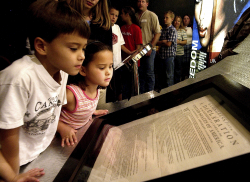The Indo-Pacific situation demands a rugged, durable amphibious logistics platform. The LCU 1700 will provide it.
The US Navy is seeking a second contractor to build its new Landing Craft, Utility (LCU) 1700 series vessels after last year’s termination of Louisiana-based Swiftships, which held the original prime contract, granted in 2018. Alabama’s Austal USA won the secondary contract in 2023. The Navy terminated Swiftships’ contract in 2024, reportedly over issues with finalizing the LCU 1700’s design.
The Navy will not take delivery of any Swiftships-built LCUs. The company was contracted to build at least seven vessels. Navy budget documents reveal that Austal USA is contracted for five LCUs, with options for up to seven additional craft. Those same documents, obtained by Breaking Defense, state that the Navy is budgeting $295 million for nine LCUs and to develop a second shipyard for their construction. Congress wants the Navy to procure two LCU 1700s per year at $25 million per vessel.
The LCU 1700 Will Be a Workhorse
The LCU 1700 will replace the Navy’s aging, Vietnam-era LCU 1650 fleet, vessels which have long overrun their projected 25-year service life. The new LCU model is 139 feet long, with a beam of 31 feet and a 5.3-foot draft. Fully loaded, each LCU 1700 displaces 428 long tons (2,240 lbs. each).
The LCU is an ocean-going heavy landing craft with a crew of 13-14 sailors. It can embark two M1A1 Abrams tanks, 350 combat troops, 400 non-combat personnel, or 170 short tons (2,000 lbs. each) of cargo. The craft is designed to support amphibious and Advanced Expeditionary Base operations for the US Marine Corps.
Each LCU 1700 features a roll-on/roll-off capability via the hydraulic bow and stern ramps. The dual-ramp system allows multiple LCUs to connect to form a causeway from deeper waters to a shallow landing area or beach, if necessary. The vessel’s shallow draft allows direct debarkation on or near most beaches.
The LCU 1700 will be powered by two CAT C18 diesel engines driving twin screws, with each delivering 600 brake horsepower at the crankshaft at 1,800 rpm. Top speed is 11 knots, with a range of 1,200 nautical miles at 8 knots. Advanced navigational systems ensure the LCU will reach its destination. The LCU can also operate in a short-range capacity with larger transport ships.
Each craft is lightly armed, with mounts for four M2HB .50-caliber machine guns.
The LCU 1700’s Role
The LCU 1700 is a logistical asset, though it can function in the assault role. The LCU 1700 is primarily designed for follow-up operations involving resupply or reinforcement, such as delivering armor or artillery assets to assault troops on a secured beachhead. Its slow speed all but precludes its use in the initial assault waves, with better options like the LCAC hovercraft or the still-in-development wing-in-ground craft providing faster, more agile options.
With tensions rising in the Indo-Pacific region, it’s easy to see a role for the LCU 1700 in that theater. The craft’s ability to survive in a contested environment like the South China Sea, however, is questionable thanks to a combination of its low speed and China’s robust anti-access/area denial (A2/AD) capabilities. Strong air and naval support would be necessary for the LCU to thrive in such an environment, but its heavy-lifting capability versus the LCAC would be invaluable. The ideal scenario would see the faster LCACs transporting lighter cargoes while the LCUs handle the heavy stuff.
A Needed Asset
The LCU 1700 is long overdue, considering its predecessor’s age. A problem with Swiftships set the program back, but a secondary builder should speed up the process. The Indo-Pacific situation demands a rugged, durable amphibious logistics platform. The LCU 1700 will provide it.
About the Author: William Lawson
William Lawson is a military historian focusing on World War II and 20th century conflicts and the American Civil War. His specialty is operational level warfare, especially American amphibious doctrine. He writes on history, politics, and firearms for multiple publications and historical journals. He serves on the editorial advisory board for the Saber & Scroll Journal and Military History Chronicles and is a member of the Society for Military History and the American Historical Association. Lawson is based in Virginia.
Image: DVIDS.

















